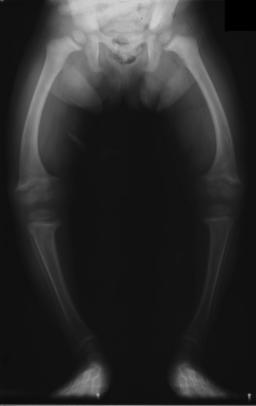Rickets history and symptoms
|
Rickets Microchapters |
|
Diagnosis |
|---|
|
Treatment |
|
Case Studies |
|
Rickets history and symptoms On the Web |
|
American Roentgen Ray Society Images of Rickets history and symptoms |
|
Risk calculators and risk factors for Rickets history and symptoms |
Editor-In-Chief: C. Michael Gibson, M.S., M.D. [1]
Please help WikiDoc by adding content here. It's easy! Click here to learn about editing.
Overview
History
Symptoms

Signs and symptoms of rickets include:
- Bone pain or tenderness
- dental problems
- muscle weakness (rickety myopathy or "floppy baby syndrome")
- increased tendency for fractures (easily broken bones), especially greenstick fractures
- Skeletal deformity
- Toddlers: Bowed legs (genu varum)
- Older children: Knock-knees (genu valgum) or "windswept knees"
- Cranial, spinal, and pelvic deformities
- Growth disturbance
- Hypocalcemia (low level of calcium in the blood), and
- Tetany (uncontrolled muscle spasms all over the body).
- Craniotabes (soft skull)
- Costochondral swelling (aka "rickety rosary" or "rachitic rosary")
- Harrison's groove
- Double malleoli sign due to metaphyseal hyperplasia [2]
An X-ray or radiograph of an advanced sufferer from rickets tends to present in a classic way: bow legs (outward curve of long bone of the legs) and a deformed chest. Changes in the skull also occur causing a distinctive "square headed" appearance. These deformities persist into adult life if not treated.
Long-term consequences include permanent bends or disfiguration of the long bones, and a curved back.